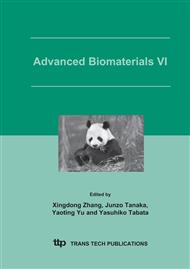[1]
T. Nakamura, T. Nishizawa, M. Hagiya, T. Seki, M. Shimonishi, A. Sugimura, K. Tashiro, and S. Shimizu. Molecular cloning and expression of human hepatocyte growth factor. Nature 342: 440-443 (1989).
DOI: 10.1038/342440a0
Google Scholar
[2]
R. Zarnegar, and G. K. Michalopoulos. The many faces of hepatocyte growth factor: from hepatopoiesis to hematopoiesis. J. Cell Biol. 129: 1177-1180 (1995).
DOI: 10.1083/jcb.129.5.1177
Google Scholar
[3]
K. Matsumoto and T. Nakamura. Hepatocyte growth factor (HGF) as a tissue organizer for organogenesis and regeneration. Biochem. Biophys. Res. Commun. 239: 639-644 (1997).
DOI: 10.1006/bbrc.1997.7517
Google Scholar
[4]
J. Cortner, G. F. Vande Woude, and S. Rong. The Met-HGF/SF autocrine signaling mechanism is involved in sarcomagenesis. EXS 74: 89-121 (1995).
DOI: 10.1007/978-3-0348-9070-0_6
Google Scholar
[5]
M. Jeffers, S. Rong, and G. F. Vande Woude. Hepatocyte growth factor/scatter factor-Met signaling in tumorigenicity and invasion / metastasis. J. Mol. Med. 74: 505-513 (1996).
DOI: 10.1007/bf00204976
Google Scholar
[6]
C. T. To and M. S. Tsao. The roles of hepatocyte growth factor/scatter factor and met receptor in human cancers. Oncol. Rep. 5: 1013-1024 (1998).
DOI: 10.3892/or.5.5.1013
Google Scholar
[7]
W. G. Jiang, S. Hiscox, K. Matsumoto, and T. Nakamura. Hepatocyte growth factor/scatter factor, its molecular, cellular and clinical implications in cancer. Crit. Rev. Oncol. Hematol. 29: 209-248 (1999).
DOI: 10.1016/s1040-8428(98)00019-5
Google Scholar
[8]
K. Date, K. Matsumoto, H. Shimura, M. Tanaka, and T. Nakamura. HGF/NK4 is a specific antagonist for pleiotrophic actions of hepatocyte growth factor. FEBS Lett. 420: 1-6 (1997).
DOI: 10.1016/s0014-5793(97)01475-0
Google Scholar
[9]
K. Date, K. Matsumoto, K. Kuba, H. Shimura, M. Tanaka, and T. Nakamura. Inhibition of tumor growth and invasion by a four-kringle antagonist (HGF/NK4) for hepatocyte growth factor. Oncogene 17: 3045-3054 (1998).
DOI: 10.1038/sj.onc.1202231
Google Scholar
[10]
K. Kuba, K. Matsumoto, K. Date, H. Shimura, M. Tanaka, and T. Nakamura. HGF/NK4, a four-kringle antagonist of hepatocyte growth factor, is an angiogenesis inhibitor that suppresses tumor growth and metastasis in mice. Cancer Res. 60: 6737-6743 (2000).
DOI: 10.1038/sj.onc.1202231
Google Scholar
[11]
T. Merdan, J. Kopecek, and T. Kissel. Prospects for cationic polymers in gene and oligonucleotide therapy against cancer. Adv. Drug Deliv. Rev. 54: 715-758 (2002).
DOI: 10.1016/s0169-409x(02)00046-7
Google Scholar
[12]
M. Matsuura, Y. Yamazaki, M. Sugiyama, M. Kondo, H. Ori, M. Nango, N. Oku. Polycation liposome-mediated gene transfer in vivo. Biochim. Biophys. Acta. 1612: 136-143 (2003).
DOI: 10.1016/s0005-2736(03)00109-3
Google Scholar
[13]
A. Veis. The physical chemistry of gelatin. Int. Rev. Connect. Tissue Res. 3: 113-200 (1965).
Google Scholar
[14]
Y. Tabata, Y. Ikada. Protein release from gelatin matrices. Adv. Drug Deliv. Rev. 31: 287-301 (1998).
Google Scholar
[15]
Y. Fukunaka, K. Iwanaga, K. Morimoto, M. Kakemi, and Y. Tabata. Controlled release of plasmid DNA from cationized gelatin hydrogels based on hydrogel degradation. J. Control. Release 80: 333-343 (2002).
DOI: 10.1016/s0168-3659(02)00026-3
Google Scholar
[16]
T. Kushibiki, R. Tomoshige, Y. Fukunaka, M. Kakemi, and Y. Tabata. In vivo release and gene expression of plasmid DNA by hydrogels of gelatin with different cationization extents. J. Control. Release 90: 207-216 (2003).
DOI: 10.1016/s0168-3659(03)00197-4
Google Scholar
[17]
H. Cohen, R. J. Levy, J. Gao, I. Fishbein, V. Kousaev, S. Sosnowski, S. Slomkowski, and G. Golomb. Sustained delivery and expression of DNA encapsulated in polymeric nanoparticles. Gene Ther. 7: 1896-1905 (2000).
DOI: 10.1038/sj.gt.3301318
Google Scholar
[18]
C. Perez, A. Sanchez, D. Putnam, D. Ting, R. Langer, and M. J. Alonso. Poly(lactic acid)-poly(ethylene glycol) nanoparticles as new carriers for the delivery of plasmid DNA. J. Control. Release 75: 211-224 (2001).
DOI: 10.1016/s0168-3659(01)00397-2
Google Scholar
[19]
L. Holmgren, M. S. O'Reilly, and J. Folkman. Dormancy of micrometastases: balanced proliferation and apoptosis in the presence of angiogenesis suppression. Nat. Med. 1: 149-153 (1995).
DOI: 10.1038/nm0295-149
Google Scholar
[20]
M. S. O'Reilly, L. Holmgren, C. Chen, and J. Folkman. Angiostatin induces and sustains dormancy of human primary tumors in mice. Nat. Med. 2: 689-692 (1996).
DOI: 10.1038/nm0696-689
Google Scholar
[21]
R. Langer. Drug delivery and targeting. Nature 392S: 5-10 (1998).
Google Scholar
[22]
F. D. Ledley. Pharmaceutical approach to somatic gene therapy. Pharm. Res. 13: 1595-1614 (1996).
Google Scholar
[23]
W. Zauner, A. Kichler, W. Schmidt, A. Sinski, and E. Wagner. Glycerol enhancement of ligand-polylysine/DNA transfection. Biotecniques 20: 905-913 (1996).
DOI: 10.2144/96205rr04
Google Scholar
[24]
P. Midoux and M. Monsigny. Efficient gene transfer by histidylated polylysine/pDNA complexes. Bioconjugate Chem. 10: 406-411 (1999).
DOI: 10.1021/bc9801070
Google Scholar


